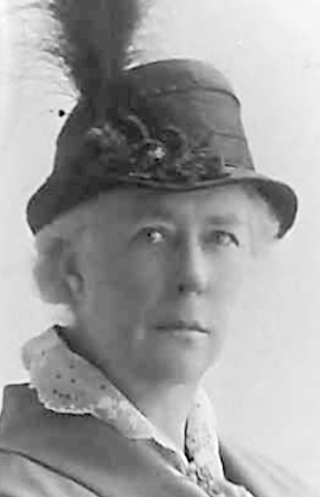
The General Federation of Women's Clubs (GFWC), founded in 1890 during the Progressive Movement, is a federation of over 3,000 women's clubs in the United States which promote civic improvements through volunteer service. Many of its activities and service projects are done independently by local clubs through their communities or GFWC's national partnerships. GFWC maintains nearly 70,000 members throughout the United States and internationally. GFWC remains one of the world's largest and oldest nonpartisan, nondenominational, women's volunteer service organizations. The GFWC headquarters is located in Washington, D.C.
The National Federation of Music Clubs (NFMC) is an American non-profit philanthropic music organization that promotes American music, performers, and composers. NFMC endeavors to strengthen quality music education by supporting "high standards of musical creativity and performance." NFMC headquarters are located in Greenwood, Indiana.

Edna Buckman Kearns was a suffrage activist who worked on the 1915 and 1917 New York campaigns for votes for women, as well as the National Woman's Party campaign for the passage and ratification of the 19th amendment to the US Constitution.

Nina Evans Allender was an American artist, cartoonist, and women's rights activist. She studied art in the United States and Europe with William Merritt Chase and Robert Henri. Allender worked as an organizer, speaker, and campaigner for women's suffrage and was the "official cartoonist" for the National Woman's Party's publications, creating what became known as the "Allender Girl."
Laura Curtis Bullard (1831–1912) was an American writer and women's rights activist. She founded a newspaper called The Ladies' Visitor, and Drawing Room Companion and published two novels with women's rights themes, the best known of which is Christine: or, Woman's Trials and Triumphs. She was elected as a corresponding secretary for the National Woman Suffrage Association, led by Elizabeth Cady Stanton and Susan B. Anthony, at its founding meeting. She succeeded Stanton as editor of The Revolution, a women's rights newspaper founded by Stanton and Anthony.

Alice Morgan Wright was an American sculptor, suffragist, and animal welfare activist. She was one of the first American artists to embrace Cubism and Futurism.

Caroline Lexow Babcock was an American pacifist and suffragist, co-founder of the Women's Peace Union, and Executive Secretary of the National Women's Party from 1938 to 1946.

The Texas Equal Suffrage Association (TESA) was an organization founded in 1903 to support white women's suffrage in Texas. It was originally formed under the name of the Texas Woman Suffrage Association (TWSA) and later renamed in 1916. TESA did allow men to join. TESA did not allow black women as members, because at the time to do so would have been "political suicide." The El Paso Colored Woman's Club applied for TESA membership in 1918, but the issue was deflected and ended up going nowhere. TESA focused most of their efforts on securing the passage of the federal amendment for women's right to vote. The organization also became the state chapter of the National American Woman Suffrage Association (NAWSA). After women earned the right to vote, TESA reformed as the Texas League of Women Voters.

Emma Beckwith was an American suffragette, bookkeeper, optician, and inventor.

The New York State Association Opposed to Woman Suffrage (NYSAOWS) was an American anti-suffrage organization in New York. The group was made up of prominent women who fought against the cause of women's suffrage by giving speeches, handing out materials and pamphlets and also publishing a journal. There were several auxiliaries of the group throughout New York and it was considered one of the most active anti-suffrage groups in the state.

Helen Losanitch Frothingham was a Serbian humanitarian aid worker, women's rights activist, nurse and writer. During World War I, she travelled from Serbia to the United States to secure relief packages from donors to help soldiers and orphans. When the war ended, she established an orphanage in Guéthary, France to care for orphans of the Spanish Civil War. She was honoured for her service with Serbia's highest award, the Order of the White Eagle.

Oreola Williams Haskell was an American activist for suffrage, author, and poet in the early twentieth century.

Elizabeth Monroe Richards Tilton was an American suffragist, a founder of the Brooklyn Woman's Club, and a poetry editor of The Revolution, the newspaper of the National Woman Suffrage Association, founded by woman's rights advocates Elizabeth Cady Stanton and Susan B. Anthony. Elizabeth Tilton also served on the executive committee of the American Equal Rights Association.

Pauline Arnoux MacArthur was an American clubwoman, writer, pianist and librettist.

Clara Schlee Laddey was a German-born American suffragist and lecturer on women's rights.

Elisabeth Worth Muller was an American suffragist.

Lillian GonzalesKohlhamer, also known as Lillian Gottlieb Kohlhamer, was an American suffragist and peace activist, based in Chicago. She was one of the American delegates to the International Congress of Women held in The Hague in 1915, and at the International Woman Suffrage Alliance conference in Geneva in 1920.

Rose Morgan French was an American suffragist, temperance and peace activist. She represented California suffragists as a delegate to the International Congress of Women, when it met in The Hague in 1915, and in Zürich in 1919.

Eugénie M. Rayé-Smith was an American lawyer, educator and suffragist.

















